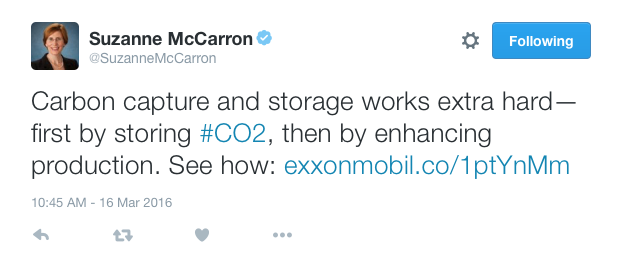ExxonMobil today tweeted this:
While injecting CO2 into oil reservoirs certainly helps produce hard-to-get-at oil (called “enhanced oil production” or EOR), it does not store CO2 on a net basis (called “carbon capture & storage” or CCS). Here is the calculation.
Baseline Assumption
About 2 billion cubic feet (ft3) of captured CO2 are used to produce about 280,000 barrels of oil per day (BOPD), according to the Department of Energy.
Method 1.
Since 1 ft3 = 0.0283168 m3, then 2 billion ft3 of CO2 = 56,633,600 m3
1 metric ton of CO2 occupies 556.2 m3
So 56,633,600 m3 of CO2 divided by 556.2 m3/ton = 101,822 tons of CO2
Then 101,822 tons of captured CO2 are used to produce 280,000 BOPD
But burning 1 barrel of oil produces 0.43 tons of CO2, according to the EPA. So burning 280,000 barrels of oil produces 120,400 tons of CO2.
So 101,822 tons of captured CO2 produces 120,400 tons of CO2 from EOR.
Method 2.
1 short ton of CO2 occupies 16,200 ft3, so 1 metric ton occupies 16,200 ft3 x 1.1023 = 17,857 ft3
2 billion ft3 of captured CO2 then weighs 111,999 metric tons.
So 111,999 metric tons of captured CO2 produces 120,400 tons of CO2 from EOR
Conclusion
Captured CO2 used in EOR produces even more CO2 through oil consumption.

That’s assuming CO2 at atmospheric pressure, right? Wouldn’t it actually be pumped in under high pressure?
I’m surprised your calculations are so close. I would have thought a little CO2 would have freed up a lot of oil, and hence led to lots of CO2 emissions.